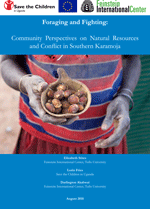This joint publication by the Feinstein International Center and Save the Children in Uganda examines the perspectives and experiences of communities in the southern Karamoja region of Uganda regarding natural resources and conflict. The study set out to better understand local views on this topic in response to the assumption in policy circles that resource scarcity or competition drives the conflict in this pastoral and agro-pastoral area. We found that while sites of natural resource exploitation are often insecure, respondents in the study population did not attribute this to direct conflict over the resources themselves. Rather, violence is common in these locations because opposing groups are most likely to come into contact with each other at these sites. On the flip side, respondents stressed that peace allows for better sharing of resources and better management of resource scarcity in times of stress or hardship.
We found increased and heavy exploitation of natural resources as part of survival subsistence strategies. The collection and sale of firewood by women has become the primary means of supporting households in most study sites. Resources accessed by women (including firewood and wild fruits and vegetables) have gained prominence in household livelihood strategies at the same time that resources important to pastoral livelihoods – namely pasture and watering points for animals —- have decreased in relevance due to the loss of animals to disease, insecurity, or restrictions on mobility. This shift towards female-controlled resources has led to a governance gap in the management of natural resources. Male elders had clear systems to manage pastoral resources in the past, but lack the mechanisms to govern access to forests and wild foods. This governance gap in customary systems is mirrored by a gap at the official level caused by lack of capacity, funding, and political will among district authorities. The resulting rapid exploitation of resources is leading to deforestation, erosion, and increased insecurity for women who travel greater and greater distances to find the firewood or wild food to provide for their families.
In examining barriers to natural resources, we found that access to resources was perceived as a much greater problem than availability of resources at the local level. Insecurity was the main obstacle to accessing resources, and threat of attack was as substantial a barrier as actual or reported attacks. Men and women had very different perspectives on the importance of different resources, and responses aligned closely with traditional gendered divisions of labor and the associated resources consumed







